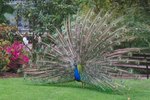
Whether you call them roly-polies, sow bugs, doodle bugs, pill bugs or one of the several other common terms for Armadillidium vulgare -- the most commonly seen species in the United States -- one thing is certain: They aren’t actually bugs at all. With their two pairs of antennae and seven pairs of legs, they are neither insects nor spiders but tiny terrestrial crustaceans in the same family as shrimps and lobsters.
Boy or Girl
Roly-polies, like many other animals, exhibit some degree of sexual dimorphism, although in the case of these small crustaceans, the differences are slight and hard to detect. Among other traits, adult male roly-polies have slightly longer antennae than females. Both sexes grow at the same rate and are generally equal in size throughout the various stages of their lives. The only reliable way to sex a roly-poly is to turn it over and look at the critter's underside -- which is pretty difficult to do with something named for its ability to roll into a tight ball. Females have growths on some legs that resemble leaves. Those develop into brood pouches for young isopods after mating. Males have special copulatory organs formed from their first two appendages.
Keeping Roly-Polies
Kids love these fascinating little creatures and often want to keep them as pets. They are interesting; but like all living things, they should be given proper care and an environment they can thrive in. Create a vivarium in a clear plastic box partially filled with damp soil and leaf litter. Gather the entire group from the same place, since they like to stay with the same mate and raise their families together. Place a piece of bark, stone or cardboard in the container to give them shelter, and always keep the soil slightly damp. Roly-polies are omnivores -- meaning they will eat both plant and animal material -- they will especially enjoy being given moncotyledonous leaves, which are those with parallel veins, such as banana, bamboo or grass leaves.
Pet or Pest
Unfortunately for these inoffensive creatures, many people believe them to be pests and exterminate them. Roly-polies do eat vegetable matter but, contrary to popular opinion, they are not major garden pests -- they actually contribute to garden health by working to break down compost and decayed leaves. They are among the planet’s tiny overlooked scavengers, working hard to recycle the world’s garbage into healthy soil. They will eat small, healthy leaves as well, but those constitute such a small part of their diet that roly-polies are never a serious threat to the garden.
Fun Facts
Most roly-polies look gray in the United States, but in Europe, at least one species sports a red spot that makes the bug resemble a black widow spider, to help keep enemies at bay.
Roly-polies breathe through gills like a fish and must live in a moist environment.
Roly-poly parents stay with their young until they mature and move out of the home nest for new territory. Even then, the kids move only about 40 to 400 feet away.
Roly-polies have blue blood. When they’re sick, roly-polies turn bright blue.
References
- Harvard University Linguistics Department: The Harvard Dialect Survey
- University of Kentucky Department of Entomology: Wee Beasties
- Tel: Archives: Reproductive Strategies In Terrestrial Isopod Crustaceans
- The University of Arizona, Center for Insect Science Education Outreach: Isopod, Pillbug, Sow Bug Information
- Animal Diversity Web: Armadillidium Vulgare
- Smithsonian National Museum of Natural History: World List of Marine, Freshwater and Terrestrial Isopod Crustaceans
- Bug Facts: Pill Bug (Rollie Pollie)
- The Northwest Environmental Center: The Kids' Page: Roly Polys, Pill Bugs, Sow Bugs, and Potato Bugs
Photo Credits
-
Jupiterimages/Photos.com/Getty Images



